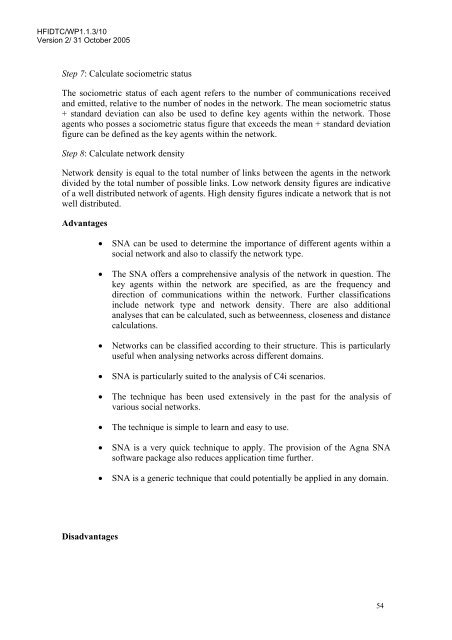A Review of the Event Analysis of Systemic Teamwork Methodology
A Review of the Event Analysis of Systemic Teamwork Methodology
A Review of the Event Analysis of Systemic Teamwork Methodology
- No tags were found...
Create successful ePaper yourself
Turn your PDF publications into a flip-book with our unique Google optimized e-Paper software.
HFIDTC/WP1.1.3/10<br />
Version 2/ 31 October 2005<br />
Step 7: Calculate sociometric status<br />
The sociometric status <strong>of</strong> each agent refers to <strong>the</strong> number <strong>of</strong> communications received<br />
and emitted, relative to <strong>the</strong> number <strong>of</strong> nodes in <strong>the</strong> network. The mean sociometric status<br />
+ standard deviation can also be used to define key agents within <strong>the</strong> network. Those<br />
agents who posses a sociometric status figure that exceeds <strong>the</strong> mean + standard deviation<br />
figure can be defined as <strong>the</strong> key agents within <strong>the</strong> network.<br />
Step 8: Calculate network density<br />
Network density is equal to <strong>the</strong> total number <strong>of</strong> links between <strong>the</strong> agents in <strong>the</strong> network<br />
divided by <strong>the</strong> total number <strong>of</strong> possible links. Low network density figures are indicative<br />
<strong>of</strong> a well distributed network <strong>of</strong> agents. High density figures indicate a network that is not<br />
well distributed.<br />
Advantages<br />
• SNA can be used to determine <strong>the</strong> importance <strong>of</strong> different agents within a<br />
social network and also to classify <strong>the</strong> network type.<br />
• The SNA <strong>of</strong>fers a comprehensive analysis <strong>of</strong> <strong>the</strong> network in question. The<br />
key agents within <strong>the</strong> network are specified, as are <strong>the</strong> frequency and<br />
direction <strong>of</strong> communications within <strong>the</strong> network. Fur<strong>the</strong>r classifications<br />
include network type and network density. There are also additional<br />
analyses that can be calculated, such as betweenness, closeness and distance<br />
calculations.<br />
• Networks can be classified according to <strong>the</strong>ir structure. This is particularly<br />
useful when analysing networks across different domains.<br />
• SNA is particularly suited to <strong>the</strong> analysis <strong>of</strong> C4i scenarios.<br />
• The technique has been used extensively in <strong>the</strong> past for <strong>the</strong> analysis <strong>of</strong><br />
various social networks.<br />
• The technique is simple to learn and easy to use.<br />
• SNA is a very quick technique to apply. The provision <strong>of</strong> <strong>the</strong> Agna SNA<br />
s<strong>of</strong>tware package also reduces application time fur<strong>the</strong>r.<br />
• SNA is a generic technique that could potentially be applied in any domain.<br />
Disadvantages<br />
54
















